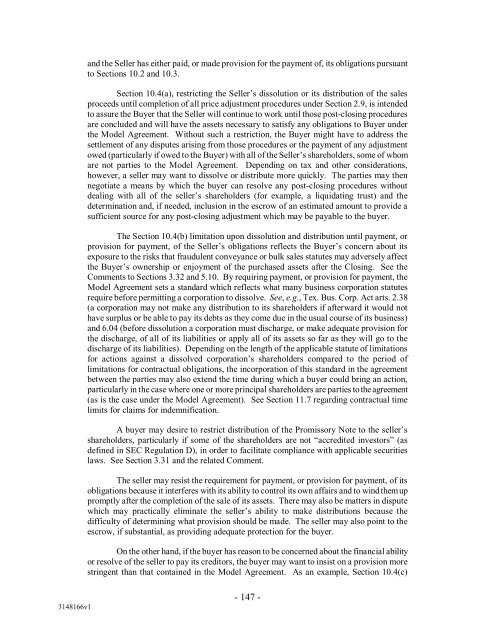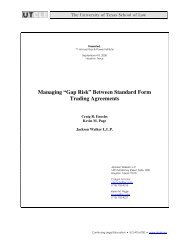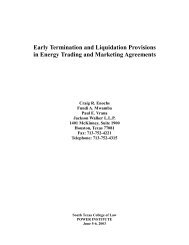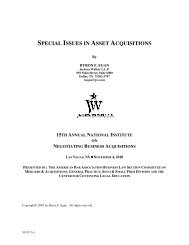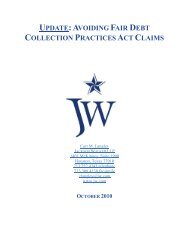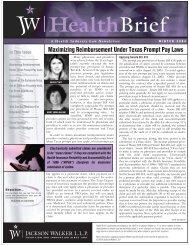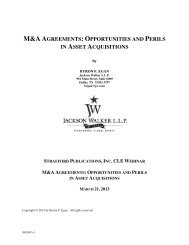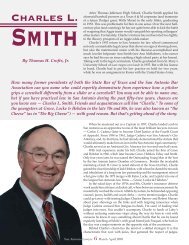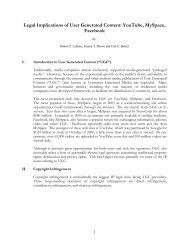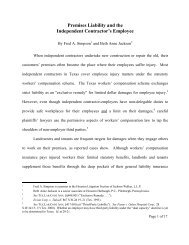asset acquisitions - Jackson Walker LLP
asset acquisitions - Jackson Walker LLP
asset acquisitions - Jackson Walker LLP
Create successful ePaper yourself
Turn your PDF publications into a flip-book with our unique Google optimized e-Paper software.
and the Seller has either paid, or made provision for the payment of, its obligations pursuantto Sections 10.2 and 10.3.Section 10.4(a), restricting the Seller’s dissolution or its distribution of the salesproceeds until completion of all price adjustment procedures under Section 2.9, is intendedto assure the Buyer that the Seller will continue to work until those post-closing proceduresare concluded and will have the <strong>asset</strong>s necessary to satisfy any obligations to Buyer underthe Model Agreement. Without such a restriction, the Buyer might have to address thesettlement of any disputes arising from those procedures or the payment of any adjustmentowed (particularly if owed to the Buyer) with all of the Seller’s shareholders, some of whomare not parties to the Model Agreement. Depending on tax and other considerations,however, a seller may want to dissolve or distribute more quickly. The parties may thennegotiate a means by which the buyer can resolve any post-closing procedures withoutdealing with all of the seller’s shareholders (for example, a liquidating trust) and thedetermination and, if needed, inclusion in the escrow of an estimated amount to provide asufficient source for any post-closing adjustment which may be payable to the buyer.The Section 10.4(b) limitation upon dissolution and distribution until payment, orprovision for payment, of the Seller’s obligations reflects the Buyer’s concern about itsexposure to the risks that fraudulent conveyance or bulk sales statutes may adversely affectthe Buyer’s ownership or enjoyment of the purchased <strong>asset</strong>s after the Closing. See theComments to Sections 3.32 and 5.10. By requiring payment, or provision for payment, theModel Agreement sets a standard which reflects what many business corporation statutesrequire before permitting a corporation to dissolve. See, e.g., Tex. Bus. Corp. Act arts. 2.38(a corporation may not make any distribution to its shareholders if afterward it would nothave surplus or be able to pay its debts as they come due in the usual course of its business)and 6.04 (before dissolution a corporation must discharge, or make adequate provision forthe discharge, of all of its liabilities or apply all of its <strong>asset</strong>s so far as they will go to thedischarge of its liabilities). Depending on the length of the applicable statute of limitationsfor actions against a dissolved corporation’s shareholders compared to the period oflimitations for contractual obligations, the incorporation of this standard in the agreementbetween the parties may also extend the time during which a buyer could bring an action,particularly in the case where one or more principal shareholders are parties to the agreement(as is the case under the Model Agreement). See Section 11.7 regarding contractual timelimits for claims for indemnification.A buyer may desire to restrict distribution of the Promissory Note to the seller’sshareholders, particularly if some of the shareholders are not “accredited investors” (asdefined in SEC Regulation D), in order to facilitate compliance with applicable securitieslaws. See Section 3.31 and the related Comment.The seller may resist the requirement for payment, or provision for payment, of itsobligations because it interferes with its ability to control its own affairs and to wind them uppromptly after the completion of the sale of its <strong>asset</strong>s. There may also be matters in disputewhich may practically eliminate the seller’s ability to make distributions because thedifficulty of determining what provision should be made. The seller may also point to theescrow, if substantial, as providing adequate protection for the buyer.On the other hand, if the buyer has reason to be concerned about the financial abilityor resolve of the seller to pay its creditors, the buyer may want to insist on a provision morestringent than that contained in the Model Agreement. As an example, Section 10.4(c)3148166v1- 147 -


